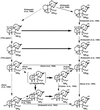Gibberellin Biosynthesis in Maize. Metabolic Studies with GA(15), GA(24), GA(25), GA(7), and 2,3-Dehydro-GA(9)
- PMID: 10557253
- PMCID: PMC59468
- DOI: 10.1104/pp.121.3.1037
Gibberellin Biosynthesis in Maize. Metabolic Studies with GA(15), GA(24), GA(25), GA(7), and 2,3-Dehydro-GA(9)
Abstract
[17-(14)C]-Labeled GA(15), GA(24), GA(25), GA(7), and 2,3-dehydro-GA(9) were separately injected into normal, dwarf-1 (d1), and dwarf-5 (d5) seedlings of maize (Zea mays L.). Purified radioactive metabolites from the plant tissues were identified by full-scan gas chromatography-mass spectrometry and Kovats retention index data. The metabolites from GA(15) were GA(44), GA(19), GA(20), GA(113), and GA(15)-15,16-ene (artifact?). GA(24) was metabolized to GA(19), GA(20), and GA(17). The metabolites from GA(25) were GA(17), GA(25) 16alpha,17-H(2)-17-OH, and HO-GA(25) (hydroxyl position not determined). GA(7) was metabolized to GA(30), GA(3), isoGA(3) (artifact?), and trace amounts of GA(7)-diene-diacid (artifact?). 2,3-Dehydro-GA(9) was metabolized to GA(5), GA(7) (trace amounts), 2,3-dehydro-GA(10) (artifact?), GA(31), and GA(62). Our results provide additional in vivo evidence of a metabolic grid in maize (i.e. pathway convergence). The grid connects members of a putative, non-early 3,13-hydroxylation branch pathway to the corresponding members of the previously documented early 13-hydroxylation branch pathway. The inability to detect the sequence GA(12) --> GA(15) --> GA(24) --> GA(9) indicates that the non-early 3,13-hydroxylation pathway probably plays a minor role in the origin of bioactive gibberellins in maize.
Figures


Similar articles
-
The dwarf-1 (dt) Mutant of Zea mays blocks three steps in the gibberellin-biosynthetic pathway.Proc Natl Acad Sci U S A. 1996 Sep 17;93(19):10515-8. doi: 10.1073/pnas.93.19.10515. Proc Natl Acad Sci U S A. 1996. PMID: 11607708 Free PMC article.
-
Qualitative and Quantitative Analyses of Gibberellins in Vegetative Shoots of Normal, dwarf-1, dwarf-2, dwarf-3, and dwarf-5 Seedlings of Zea mays L.Plant Physiol. 1988 Dec;88(4):1367-72. doi: 10.1104/pp.88.4.1367. Plant Physiol. 1988. PMID: 16666468 Free PMC article.
-
The dominant non-gibberellin-responding dwarf mutant (D8) of maize accumulates native gibberellins.Proc Natl Acad Sci U S A. 1988 Dec;85(23):9031-5. doi: 10.1073/pnas.85.23.9031. Proc Natl Acad Sci U S A. 1988. PMID: 16594001 Free PMC article.
-
Hydrolysis and reconjugation of gibberellin A20 glucosyl ester by seedlings of Zea mays L.Proc Natl Acad Sci U S A. 1992 Sep 1;89(17):8045-8. doi: 10.1073/pnas.89.17.8045. Proc Natl Acad Sci U S A. 1992. PMID: 1518829 Free PMC article.
-
Gibberellin A(3) Is Biosynthesized from Gibberellin A(20) via Gibberellin A(5) in Shoots of Zea mays L.Plant Physiol. 1990 Sep;94(1):127-31. doi: 10.1104/pp.94.1.127. Plant Physiol. 1990. PMID: 16667678 Free PMC article.
Cited by
-
Quo vadis plant hormone analysis?Planta. 2014 Jul;240(1):55-76. doi: 10.1007/s00425-014-2063-9. Epub 2014 Mar 28. Planta. 2014. PMID: 24677098 Review.
References
-
- Croker SJ, Gaskin P, Hedden P, MacMillan J, MacNeil KAG. Quantitative analysis of gibberellins by isotope dilution mass spectrometry: a comparison of the use of calibration curves, an isotope dilution fit program and arithmetical correction of isotope ratios. Phytochem Anal. 1994;5:74–80.
-
- Davis G, Kobayashi M, Phinney BO, MacMillan J, Gaskin P. The metabolism of GA9 in maize (Zea mays) Phytochemistry. 1998;47:635–639.
LinkOut - more resources
Full Text Sources
Other Literature Sources

